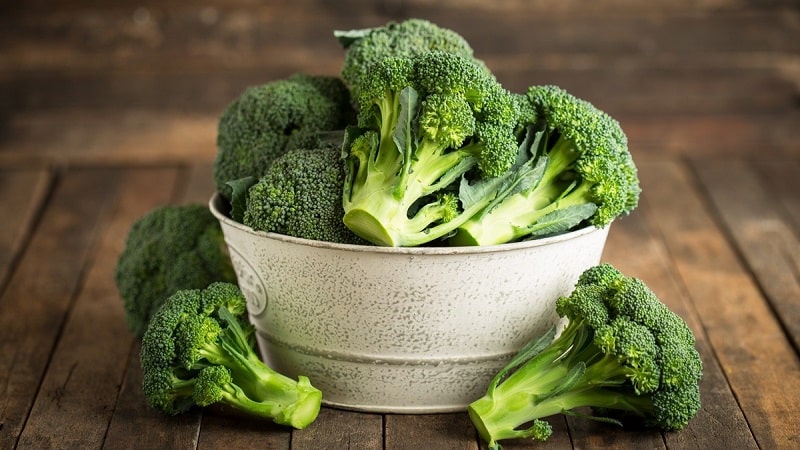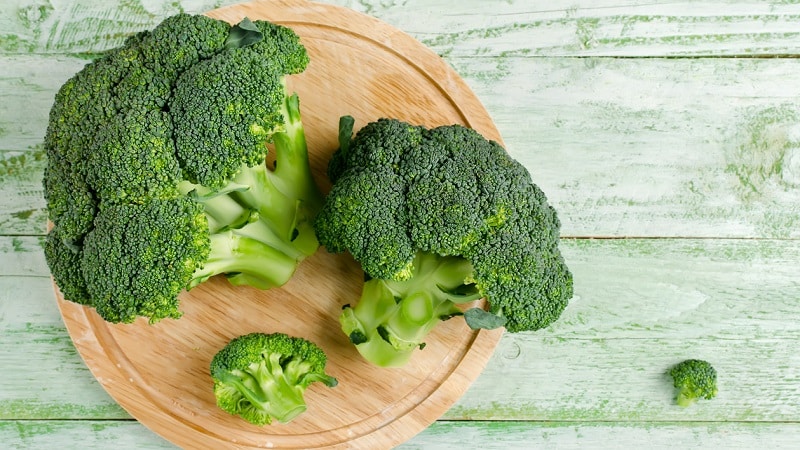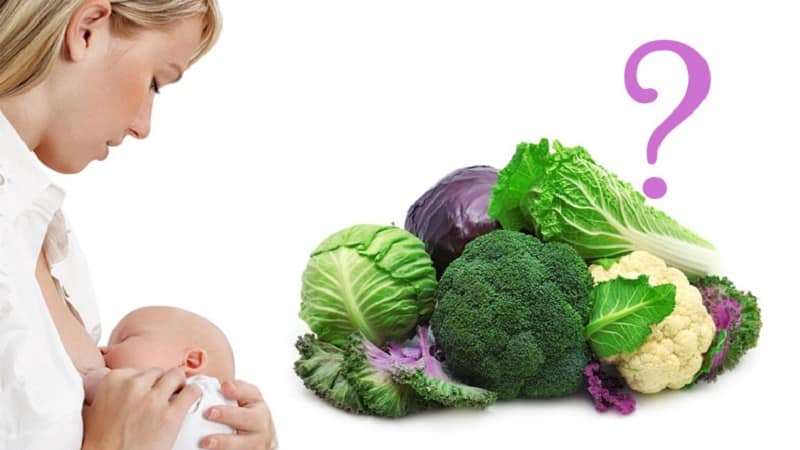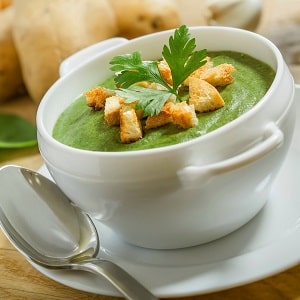Is it possible to include broccoli in the diet while breastfeeding?
Breast milk is the healthiest food for a small child. In order not to harm the baby’s fragile body, a nursing mother needs to properly plan her diet. It is important to select only healthy and safe products. We will talk about the nuances of eating one of the most “vitamin-rich” vegetables during this period – broccoli.
Is it possible to eat broccoli during breastfeeding?
Safe foods allowed during breastfeeding include broccoli. By eating dishes made from this vegetable, women do not have to worry about the health of the child.

Compound
This cabbage contains a lot of useful vitamins and microelements. In addition, the vegetable is considered dietary due to its low calorie content (34 kcal per 100 g).
All data are given per 100 g.
BJU:
- fats – 0.37;
- proteins – 2.82;
- carbohydrates – 6.64;
- water – 89.3;
- ash – 0.87.
Vitamins:
- vitamin A – 31 mcg;
- alpha-carotene – 25 mcg;
- beta-carotene – 361 mcg;
- vitamin E – 0.8 mg;
- vitamin C – 89.2 mg;
- vitamin K – 101.6 mcg;
- vitamin B4 – 18.7 mg;
- vitamin B9 – 63 mcg.
Broccoli contains much more vitamin C than any citrus fruit.. The daily requirement for ascorbic acid in an adult is met by consuming just 100 g of broccoli.
Minerals:
- potassium – 316 mg;
- sodium – 33 mg;
- phosphorus – 66 mg;
- magnesium – 21 mg;
- calcium – 47 mg;
- selenium – 2.5 mcg.
Beneficial features
Regular consumption of cabbage makes a person healthier. The beneficial properties of the vegetable include assistance in such processes:
- removal of excess salts from the body;
- beneficial effects on the functioning of the heart and nervous system;
- support healthy nail and hair growth;
- reducing the risk of strokes and heart attacks;
- preventing the accumulation of cholesterol in the body;
- normalization of insulin levels;
- normalization of stomach function.
Contraindications
Those with high stomach acidity should not eat raw broccoli.. It is also better to do without this vegetable for people who are prohibited from foods with coarse fiber.
Sometimes rare cases of individual intolerance to cabbage occur, in which case it is excluded from the diet.
Interesting things on the site:
Is it possible to eat stewed cabbage while breastfeeding?
Benefits and harms for the mother
Eating broccoli helps strengthen immunity and improve health nursing woman. In the first difficult months of life with a baby, a green vegetable will be most appropriate, as it helps fight stress.
Tryptophan contained in broccoli is involved in the production of serotonin, called the “happiness hormone”.

Besides, The low calorie content of cabbage (35 kcal per 100 g) boiled or stewed helps a woman quickly return to her previous figure. However, you should not try raw broccoli to avoid stomach problems. It is also not recommended to eat cabbage fried, otherwise harmful carcinogens released during the heating of the oil will get into the food.
Important. After a caesarean section, you should not eat broccoli in the first weeks.All organs of the intestinal tract after surgery are in a relaxed state. Eating cabbage will cause gas to accumulate and slow down the movement of food.
Besides, Women who are breastfeeding should not try broccoli broth., since the liquid contains substances harmful to the child - guanine and adenine.
For a child
Although broccoli is considered a safe food, sometimes eating it at the beginning of complementary feeding can cause A six-month-old baby has flatulence and bloating. In this case, cabbage is excluded from the diet and returned to it after a month.
Rules for use during lactation
When breastfeeding, almost everything that the mother eats will end up in the milk in an adapted form.. In order not to harm the baby, it is better to refrain from eating cabbage in the first month. Otherwise, this can lead to increased flatulence and colic in the child.
How and when to introduce it into the diet
A woman can include broccoli in her home menu a month after the birth of her baby.. It is recommended to eat the vegetable boiled, steamed or in the oven. You should not eat cabbage raw, so as not to provoke colic in the baby.
What time of day and how much is there?
In the first month, breastfeeding women are recommended to start with a few spoons of broccoli soup.. It is important to monitor the condition of the baby throughout the day.
If there are no adverse reactions and mother’s milk is still well absorbed, you can increase the amount of cabbage to 100 g per day, but no more, so as not to provoke an upset stomach in the baby. When the baby turns two months old, the mother is allowed to eat a two-hundred-gram portion.
What to combine with
Cabbage can be eaten with sour cream, vegetable oil or other vegetables. Also add it to fish or meat, prepare soups, salads and casseroles from broccoli.

Is it possible to give cabbage to a child?
WHO recommends introducing broccoli into complementary foods for infants from seven months, and for bottle-fed babies - from five. The new product is offered to children in the form of purees, prepared independently or purchased in a store. For starters, half a teaspoon is enough.
After introducing a new vegetable, monitor your child’s reaction to complementary foods. If there are no changes, double the portion and bring it to 50 g by the end of the week. If the baby has colic or a swollen belly, remove cabbage from the diet for a while.
Rules for choosing broccoli
The head of cabbage should only be fresh, with bright green inflorescences, no mold, yellow sheets and black spots. A quality vegetable feels firm to the touch, and a crunch should be heard at the break point.
It is not recommended to take specimens with blossoming flowers or half-opened buds. These are signs of overripe cabbage, which has begun to lose its beneficial properties.
Read also:
Broccoli recipes for nursing mothers
After purchasing, it is better to immediately cook the cabbage or divide it into inflorescences and to freeze. It is recommended to store prepared food in the refrigerator for no more than two days. Breastfeeding women should opt for stewed, baked and boiled dishes.
Cream of broccoli soup
This soup is recommended not only for nursing mothers, but also for babies under one year old.. The taste of the dish can be varied by adding croutons, cream, other vegetables or spices.
Products:
 broccoli – 150 g;
broccoli – 150 g;- carrots – 1 pc.;
- rice – 1 tbsp.l.;
- onion – 40 g;
- water – 0.5 l;
- salt to taste.
Wash and peel the vegetables. Cut the onion into rings, finely chop the carrots and throw into the hot broth.
Then add rice and salt. Cook for 15 minutes on medium power until the rice is done. Separate the broccoli into florets and add to the pan. Cook for another ten minutes, then grind the finished soup in a blender.
Broccoli omelette in the oven
Omelette with broccoli adds variety to your usual breakfast. Can be cooked either in the oven or in a covered frying pan. Let's consider the first option.
Products:
- eggs – 2 pcs.;
- broccoli – 4-5 inflorescences;
- sour cream – 2 tbsp. l.;
- flour – 2 tsp;
- salt to taste.
Boil cabbage inflorescences in salted water. Using a blender, mix eggs, sour cream and salt. Add flour and stir until lumps disappear. Grease a baking dish with oil, place cabbage on the bottom and fill with liquid mixture. Cook the dish for 20 minutes at 190°C.
Reference. During cooking, broccoli quickly loses its beneficial qualities. Therefore, start cooking the washed vegetable immediately. Cook cabbage in boiling water for no more than seven minutes.
Chicken roll with broccoli
The dish has an unusual taste thanks to the successful combination of broccoli and cheese. You can bake not only in the oven, but also in a slow cooker in the “Baking” mode.
Products:
 chicken fillet – 300 g;
chicken fillet – 300 g;- cottage cheese – 150 g;
- broccoli – 150 g;
- hard cheese – 100 g;
- onion – 50 g;
- eggs – 2 pcs.
Using a blender or meat grinder, grind the chicken fillet. Then mix with eggs, cottage cheese, onion and salt. Place part of the resulting mass in a greased mold and make a depression.
Divide the cabbage into florets, cut and place on the minced chicken. Sprinkle with grated cheese and cover the filling with the remaining mixture, creating a roll or zraza shape.
The dish is prepared for half an hour at a temperature of 220°C.
Conclusion
Broccoli brings much more benefit to the body than harm. Therefore, nursing mothers can and should introduce this vegetable into their diet. At the same time, remember that in the first month after childbirth you should not overuse broccoli dishes, so as not to harm the baby’s weak digestion.